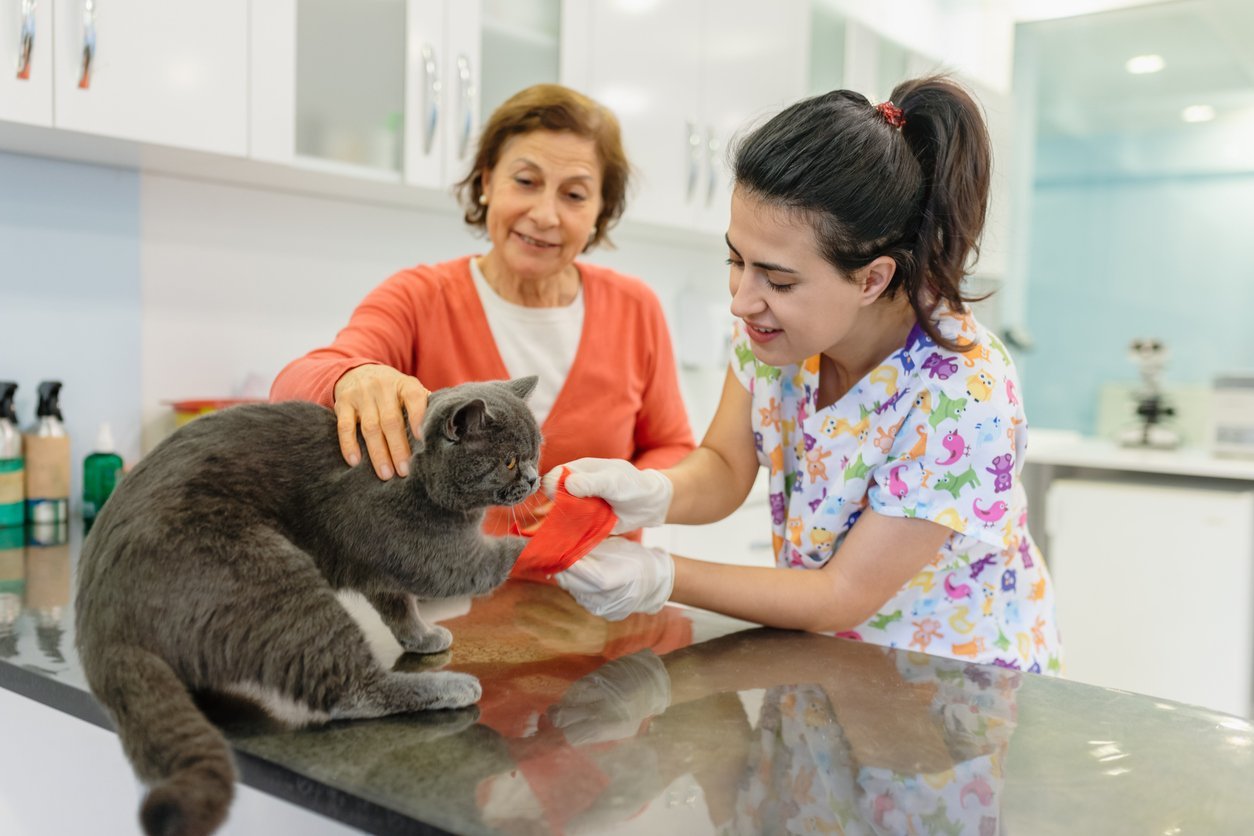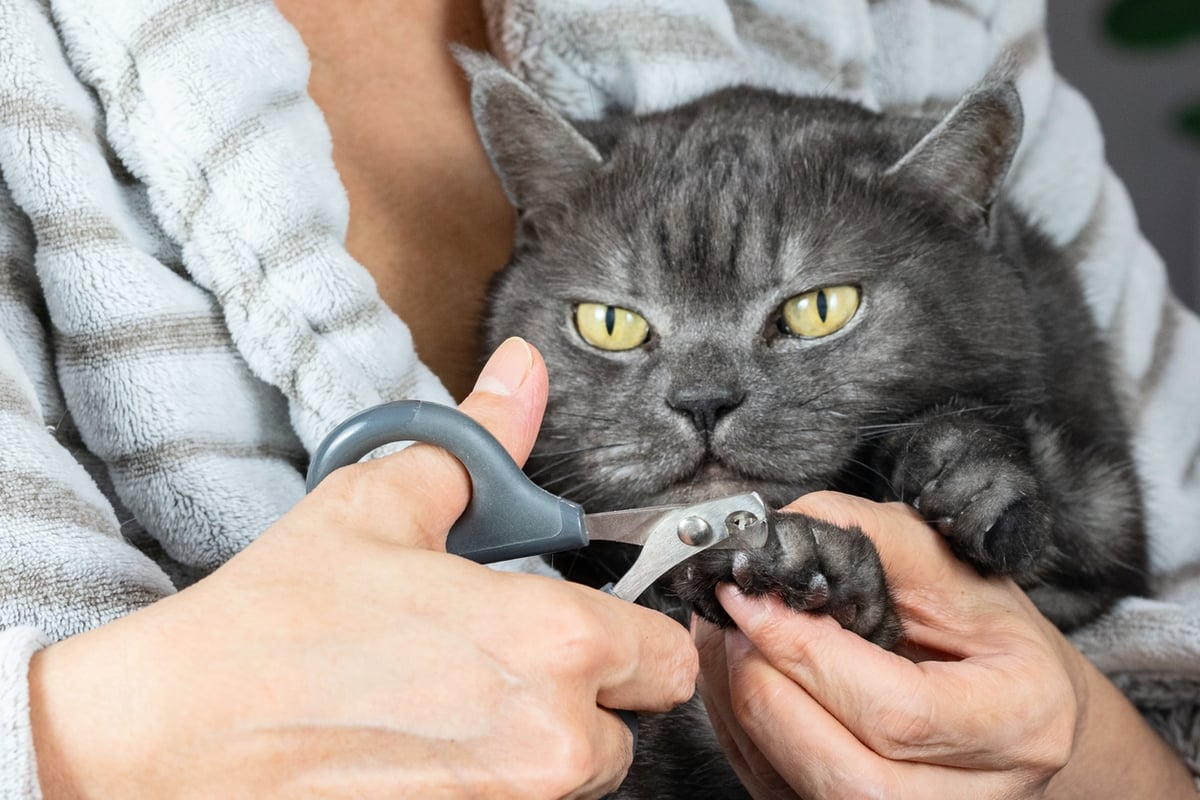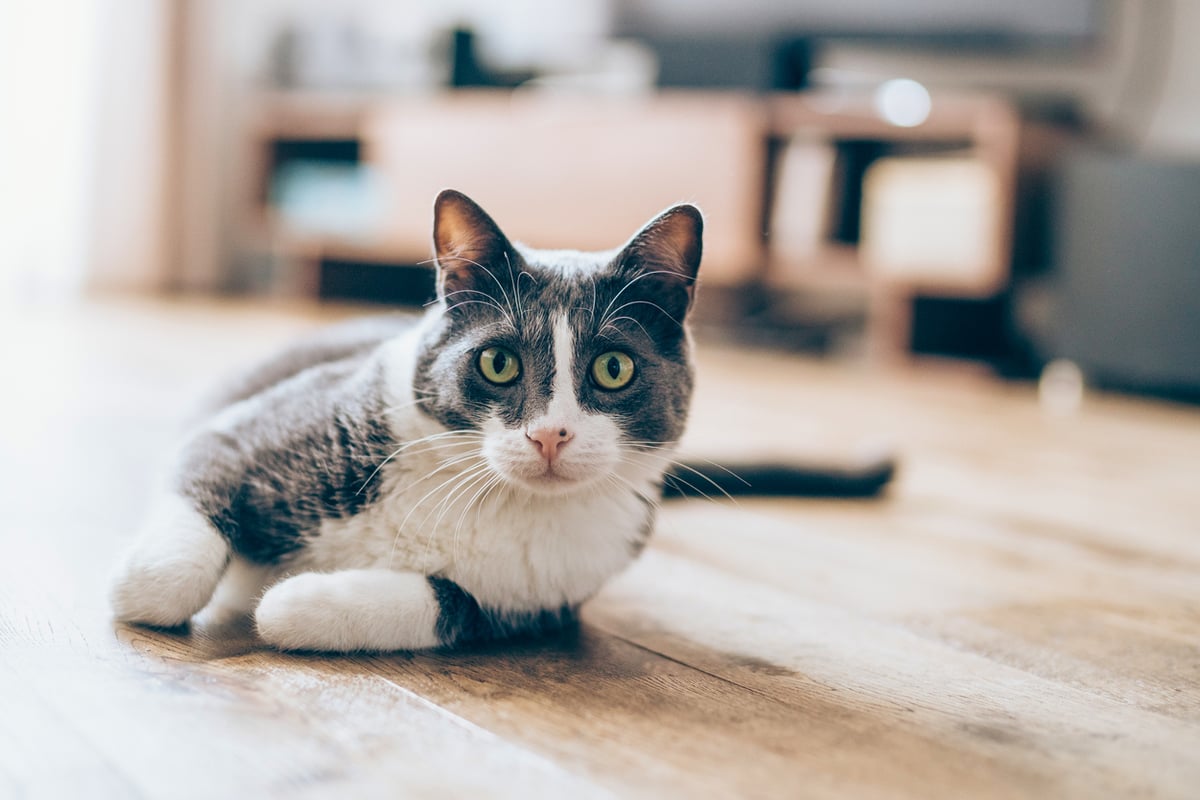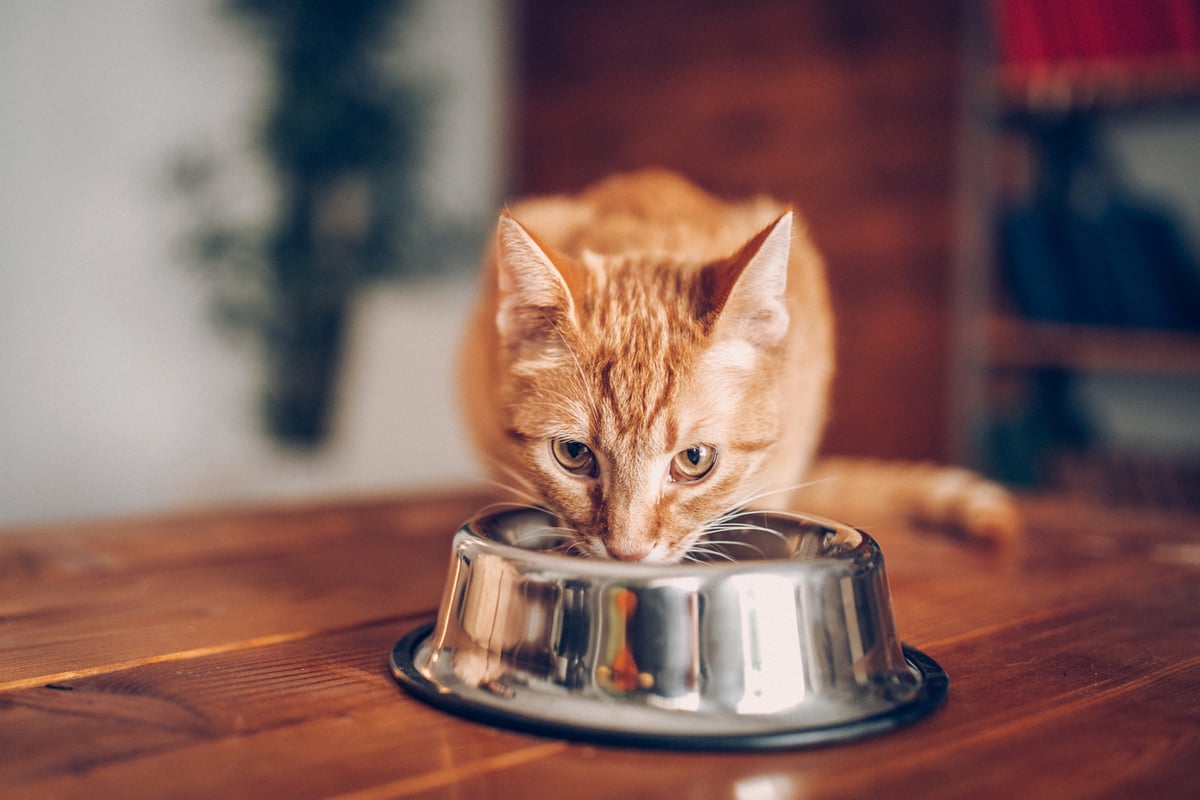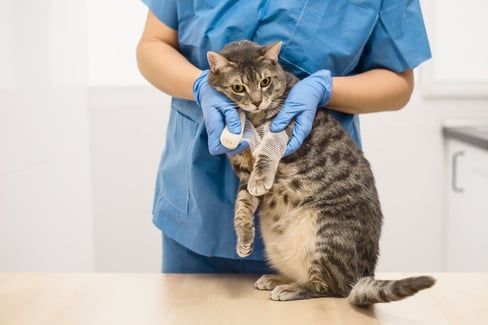Table of Contents
A cat leg injury interrupting your furry buddy’s typical zoomies isn’t fun for anyone.
When your furry friend is limping or otherwise showing signs of pain in their legs, it can be difficult to deal with.
Your first instinct is likely to do whatever you can to make your furball as comfortable as possible while at the same time trying to identify the cause of their cat leg injury, how you can help make it better, and what the next steps should be in terms of getting your cat care.
While it can be tough to see your kitty in pain, it helps to gather as much information as possible so you can make an informed decision on potential treatment options.
Let’s explore the basics surrounding cat leg injury, including identifying if your kitty is suffering from a cat leg injury, what symptoms might look like, potential causes, and more.
Cat Leg Anatomy
The first step to understanding a cat leg injury and how to help with cat pain management is to understand the anatomy of your cat’s legs.
Remember, cats are digitigrade animals. In other words, their heels don’t touch the ground, so they run on their tiptoes. That means that their legs' anatomy looks slightly different than other animals, such as dogs.
With that in mind, let’s look closer at the anatomy of a cat’s front and back legs.
Front Leg
The front legs of a cat consist of four bones:
- Radius
- Ulna
- Carpus
- Phalanges
The front leg connects directly to the humerus and scapula bones, which are part of the cat’s shoulders. One thing to note is that cat front paws tend to be able to extend their claws more than their back legs.
Back Leg
The back leg of a cat is slightly different from the front legs. The back legs consist of six different bones:
- Femur
- Fibula
- Tibia
- Tarsus
- Metatarsus
- Phalanges
The back leg of a cat connects to the pelvis. It also consists of more bones due to the longer foot. What looks like the cat’s knees on their back leg is actually the end of their foot, and the knee is located higher up, closer to the hip.
Cat Leg Injury Symptoms
If you’ve noticed signs that your cat might be suffering from a cat leg injury and are planning on taking them to the vet, it’s a very good idea to make note of any unusual symptoms your cat may be experiencing.
Because you are with your cat on a daily basis and understand their behaviour, you should be able to identify what is regular behaviour for your cat and what could be an indicator that something is wrong.
Common cat leg injury symptoms include:
- Growling, hissing, or showing uncharacteristic aggression
- Running away or hiding when you get close
- Unusual lethargic behaviour
- Reluctance to move
- Refusing to be picked up or held
Cat leg injury symptoms, in general, might be more behavioural in nature, so knowing when something is amiss with how your cat is acting can help your veterinarian come to a correct diagnosis.
One thing to note is that if you’ve got a cat in pain, the symptoms may differ slightly depending on whether your kitty is struggling with a front or back leg injury. Let’s go over each of these types of injuries in more detail.
Signs of Cat Front Leg Injury
If your kitty is limping, not wanting to put weight on their front leg, or otherwise not being themselves, they could be suffering from a cat injury to front leg
Cats have a normal instinct to mask or hide the amount of cat leg pain they are experiencing, leaving many owners asking themselves, “Is my cat in pain?” and having difficulty identifying the signs.
Signs of a cat front leg injury are objective indications that anyone can notice as evidence that your cat isn’t doing well, while symptoms are subjective. On the other hand, you might be the only one that can notice cat leg injury symptoms in your cat since you know your cat better than anyone else. We’ll start with signs and get into symptoms later.
Redness and swelling
One of the most obvious signs that your kitty isn’t feeling so hot on his front legs is if you notice redness and swelling. This could indicate a cat leg sprain, or it could mean you have a more serious cat injury on your hands.
Limping
Another common sign that you’ve got a cat front leg injury on your hands is if you notice your cat limping. In this case, your cat will not want to bear weight on his affected leg and may limp or keep his paw lifted when trying to move to avoid putting pressure on the paw.
Unusual lumps or bumps on the skin
Sometimes, unusual lumps or bumps on your cat’s skin are due to fatty tumors or due bites from parasites. However, other times they’re an indication of swelling or a non-benign tumor that could be causing cat leg pain and discomfort.
Stiffness
Difficulty moving and stiffness are two other signs that your cat is suffering from a front leg injury. The good news is that this is sometimes easily treatable with joint supplements such as TRI-ACTA This can help loosen up and lubricate the joints in the case of non-serious injuries.
TRI-ACTA H.A. for Pets
Our maximum strength formula is optimally designed to accelerate the formation of cartilage, minimize inflammation, expedite the healing process, and improve joint conditions.

Lack of appetite
When your kitty isn’t feeling well, he may stop eating. If you notice your cat lacks appetite, you may want to check out his front legs to ensure your kitty doesn’t have an injury.
Over-grooming
Animals will often groom their injuries in an attempt to help them heal and reduce pain. If you notice your cat licking or biting at his front legs, you likely have a cat front leg injury on your hands.
These signs are a clear indication that there’s something going on with your cat, whether it be a cat sprained leg or otherwise. While some of these signs may not seem like they are directly linked to a cat front leg injury, they are all typical of a cat that is experiencing some level of pain and likely needs veterinary care.
Signs of Cat Hind Leg Injury
Like front leg injuries, your cat may sometimes show signs of limping or avoiding putting weight on their back legs. These are usually surefire signs that your kitty’s hind legs are bugging him and that he may need some extra TLC to get him feeling like himself again.
Of course, these aren’t the only symptoms of a cat hind leg injury. Here are a few other common signs of a cat hind leg injury.
Pain to the touch
When you touch your kitty’s back leg, if he winces or meows in pain, he’s likely not feeling so great in his hind legs. A vet can often run a physical exam that will allow him to identify what’s causing your cat rear leg injury pain without hurting him any further.
Lack of range of motion
Cats use their hind legs to help them power up for big jumps. However, if they don’t seem as agile or aren’t using their back legs as they usually would, this is a pretty clear sign that they’ve got a cat back leg injury.
Vocalizing
Unlike humans, cats can’t tell us exactly what’s wrong with them. However, they will often meow or vocalize if they’re in pain. This is especially true if you touch or agitate their hurting hind paw.
Joint Instability
Your kitty’s joints are what help him move around and play. If he seems to be having trouble moving his joints or putting weight on his hind legs, he could be suffering from a hind leg injury. Remember, you can help prevent this type of cat mobility concern with cat supplements that help lubricate your kitty’s joints.
Panting
Kitties that are experiencing serious discomfort will sometimes pant. This can look odd, but it’s usually a sign that your kitty is stressed or in pain. If you notice your cat panting, make sure to check out his legs to ensure he’s not suffering a cat back leg injury.
Common Causes of a Cat Leg Injury 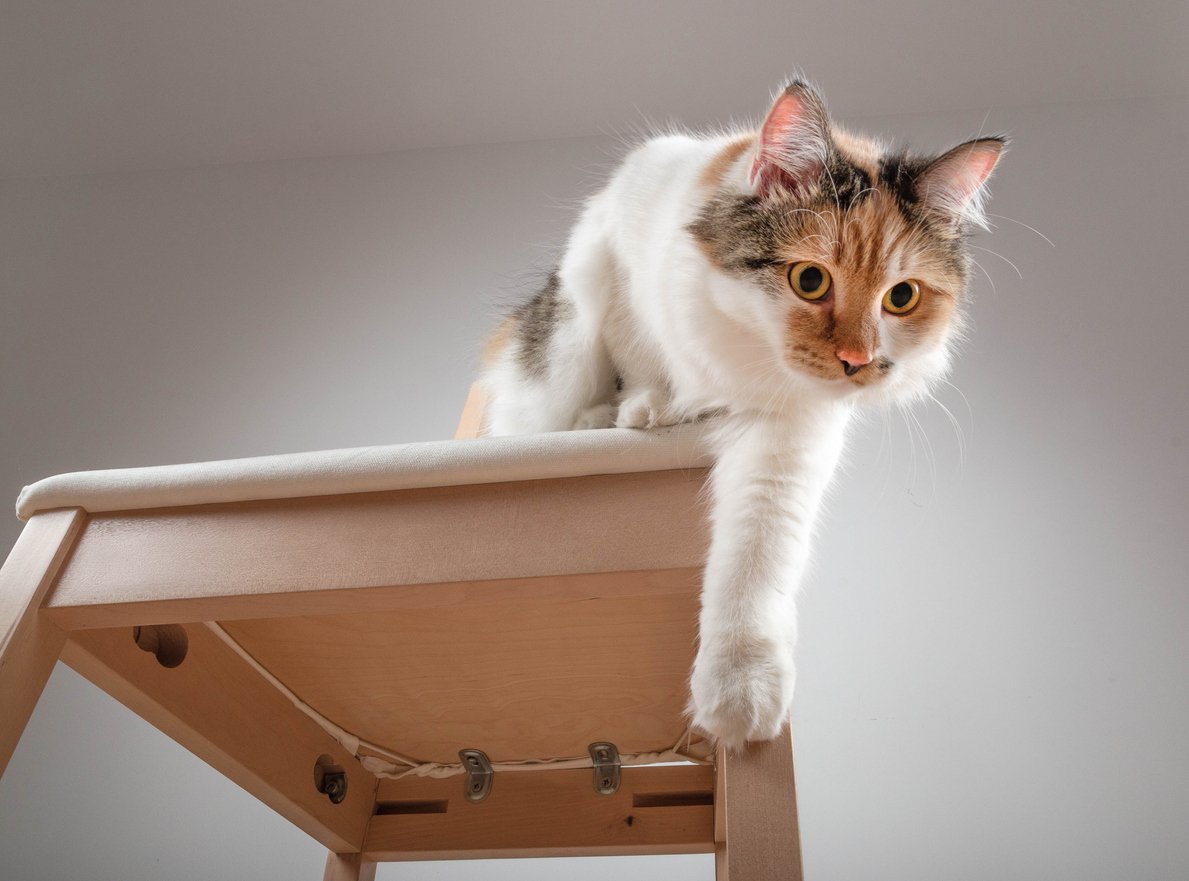
While the cause of your cat’s leg injury might be obvious, like if they fall out of a tree during a particularly ambitious stunt, there can also be underlying reasons for your cat getting a leg injury that is not so obvious.
The table below summarizes the most common causes of cat leg injuries:
| Cat Leg Injury Cause |
Description |
| Trauma |
This could be from a fall, a vehicle-related accident, a fight with another cat or animal, and more. |
| Arthritis |
This condition can cause various issues in cats, including cat leg injury. Preventions for arthritis in dogs and cats include weight management, joint supplements, and exercise. |
| High Rise Syndrome |
Cats are known for falling from high places, which can cause cat leg injuries and injuries to the cat’s internal organs. |
| Hip Dysplasia |
Genetics and hereditary reasons are often the culprits for feline hip dysplasia, which is when the hip joint develops abnormally, resulting in pain or proneness to injury. |
| Cat soft tissue injury |
Bruising, muscle strain, or pulled muscles can be the culprit behind a cat leg injury. |
| Paw and paw pad issues |
Foreign objects getting stuck in paw pads, as well as paw pad injuries like being stepped on, caught in something, or otherwise, can be an underlying cause for cat leg injuries. |
| Feline Plasma Cell Pododermatitis (Pillow Foot) |
This condition typically affects the metacarpal or metatarsal foot pads, causing swelling and a characteristic spongy, dough-like texture. |
| Insect bites or stings |
Some insects, like spiders or hornets, can bite or sting your cat’s leg causing painful lesions or bumps. |
| Overgrown nails |
Cat claws grow constantly, so without regular nail clippings, your cat’s claws might grow right into their paw pads, causing pain and bleeding. |
| Cat spinal cord injury |
It’s common for spinal cord injuries to affect the legs, causing full or partial paralysis or various neurological and bone issues which affect your cat’s ability to walk, run, and jump. |
| Brachial Plexus Avulsion |
An injury to the brachial plexus nerve group which causes pain in your cat’s chest joints and armpits and can cause front leg injury. |
More detail on each of the cat leg injury causes outlined in the table above are provided in each of the numbered sections below.
1. Trauma
Trauma happens due to things like falling out of a tree or getting hit by a car. In general, this damages your cat’s ligaments, joints, and muscles.
Trauma can cause nasty injuries and leave your kitty feeling less than his best. A couple of other types of accidents that can cause trauma to your kitty’s front and back legs include:
- Fights
- Obesity
- Repetitive strain
- Over exercise
- Household abuse
2. Arthritis
Cat arthritis is an unfortunately common condition. When your feline has arthritis, he experiences swelling joints, making moving painful and difficult. Although cat arthritis can affect any joints, it can cause front and back legs stiffness.
One of the most common places for cats to experience arthritis is their back legs. If you notice your cat avoiding one of his hind legs, it’s not a bad idea to get him checked out for arthritis.
3. High Rise Syndrome
Called Feline High Rise Syndrome, this condition actually refers to various injuries that cats can sustain when they fall from high places. As we all know, cats love to jump and climb. However, cats can sometimes underestimate the height and drop from pretty big distances — causing some pretty big consequences.
Cats who live in apartments or have balconies in the home are often at greater risk for this type of injury. Make sure to keep cats away from balconies and outdoor areas where they could get into trouble and have a fall.
4. Hip Dysplasia
When a cat has hip dysplasia, it basically means that the ball and socket of its hip are poorly aligned. This makes it tough for the femoral cat bone to move properly, which can cause partial dislocation. It also makes your cats bones knock and grind together — ouch!
Hip dysplasia causes issues for cats with their hind legs. If you notice your cat is in pain when walking or moving his back legs, it could be hip dysplasia to blame.
5. Cat Soft Tissue Injury
Soft tissue injuries often go hand-in-hand with trauma. They most often lead to cat limping or cat lameness, as your cat avoids putting his weight on the part of his body that’s hurting him.
The good news is that these injuries are usually pretty minor, so you can often treat your kitty at home without having to take him to the vet for any major operations.
6. Cat Paw and Paw Pad Issues
Cat paw and paw pad issues can also cause quite a bit of discomfort to cats. This can lead to limping or favoring a specific leg while walking. A couple of reasons why cats may experience paw injuries include:
- Lacerations
- Bites
- Overgrown claws
- Burns
7. Feline Plasma Cell Pododermatitis
Cats with plasma cell pododermatitis mean that a cat’s footpad tissue gets overrun by plasma cells. This causes painful swelling in your cat’s paws. Worse, your cat’s inflammatory response can kick in, causing further pain and swelling. The result is that your cat will often limp or try to avoid putting weight on the affected paw.
8. Insect Bites or Stings
No one likes to get stung by a bee or a wasp, and that’s just as true for our fur babies as it is for humans! If your cat is showing signs of an injury to his front or back legs, it could be due to an insect bite or sting. Examining your cats legs and paws can help you identify whether an insect was to blame for your cat’s discomfort.
9. Overgrown Nails
Cats’ nails need regular trimming. Otherwise, their claws can become overgrown, which can make it painful for them to walk. The good news is that trimming your cat’s lengthy nails down to a healthy size can be a fast and effective treatment for this issue.
10. Cat Spinal Cord Injury
Another common cause of cat leg injury is a spinal cord injury. Cat spine injuries affect your cat’s legs because the cat’s spine is directly connected to the hips and shoulders, which are connected to your cat’s front and back paws. If your cat is dealing with a spinal cord injury, he may also show signs of pain and discomfort in his legs.
11. Brachial Plexus Avulsion in Cats
Often resulting from serious trauma like a car accident, brachial plexus avulsion in cats is a result of injury to the brachial plexus group of nerves, which are located in the armpit area (where your cat’s shoulder blade joins her chest) of your cat’s front legs.
When the brachial plexus nerves are torn, avulsion has taken place. Depending on which nerves in the brachial plexus have been damaged, the signs of injury your cat will show will differ.
General signs of brachial plexus cat front leg injury include:
- Your cat cannot move their shoulder or bend their elbow. Your cat might be able to walk a bit by straightening its elbow and bearing weight on the affected front leg.
- If nerves in a different portion of the brachial plexus are damaged, then your cat might not be able to bear weight on the affected leg at all. This cat's front leg injury often causes walking with the paw turned so the cat is walking on their knuckles instead of their paw pads, with the inability to bend the shoulder or elbow.
Another condition called Horner’s Syndrome can also occur due to brachial plexus avulsion. This condition affects the eye on the same side where the avulsion occurred, causing aesthetic differences to the eye, including a droopy upper eyelid, a raised third eyelid, and a sunken appearance.

Cats suffering from Horner’s syndrome thankfully don’t often have their eyesight affected, which is a silver lining in an otherwise traumatic kitty ailment.
Cat Leg Injury Prevention Tips
Only you can prevent forest fires… or a cat leg injury.
As you can see, there are various reasons why your cat may experience leg injuries. It's natural to never want anything of the sort to happen to your feline friend, so let’s take a look at some measures that you can take to help prevent cat leg injuries.
- Adding a cat joint supplement to their diet
- Clip their nails on a regular basis
- Ensure they are safe from hazards
- Keeping them indoors
1. Using Cat Joint Supplements
One way to keep your cat healthy and avoid a cat leg injury is to add a joint supplement to their diet. A supplement can help improve the health of their bones, soft tissues, and joints. And when your cat’s systems are working in tip-top shape, it’s less likely that a leg injury will set them back.
Supplements like Integricare’s TRI-ACTA for pets offers high-quality, third-party lab-tested ingredients that are designed to:
- Repair cartilage
- Increase mobility
- Reduce inflammation in the joints
- Improve the health of connective tissues
TRI-ACTA can help the youngest of kittens grow strong and healthy. For senior cats or cats that are experiencing joint issues, TRI-ACTA H.A. is recommended. The inclusion of hyaluronic acid provides enhanced joint lubrication, providing more support for pets with joint issues. benefits.
TRI-ACTA H.A. for Pets
Our maximum strength formula is optimally designed to accelerate the formation of cartilage, minimize inflammation, expedite the healing process, and improve joint conditions.

2. Regular Nail Clipping
Clipping your cat’s nails can feel like you’ve decided to get into battle rather than participate in a regular grooming routine.
As hard as it can be to get our kitties wrangled and their nails clipped, it’s important to do it for the better of their health, and to protect them from a cat leg injury.
When nails get long, they can catch or break on almost anything, causing your cat pain in the nail itself, or worse, a cat leg injury.
Here are some tips for ensuring your cat’s nails get clipped regularly to avoid a cat leg injury:
- Start your clipping ritual when they are kittens, if pawsible. They get used to the routine and won’t be as resistant.
- Avoid taking too much off by only clipping the white tip. You can always clip more, but taking too much will cause injury.
- Give your cat a treat every time you touch their paws to get them used to it and to build an association with treats and paw maintenance.
- Take breaks if needed, and give your kitty some love and treats if they (or you!) are getting too stressed out.
3. Securing Your Raised Balconies
As we said, cats don’t always land on their feet.
If you leave windows open during a warm summer day or allow your cat to perch on the balcony or windowsill, you need to ensure your cat is secure and can’t go through the screen, over the edge of a sill, or through the slats in a railing. This helps you avoid a cat fall injury that can be serious and life-threatening.
4. Keeping Your Cat Inside
Remember when we said cats love to be daring and adventurous? Exploring the outdoors to hunt is in your cat’s DNA, so it’s no surprise domestic kitties will take any chance to get in touch with their wild side and adventure out into the wild (even if the wild is your backyard).
But before you let fluffy roam around outside, you should be aware of the potential dangers of doing so:watch out for cat leg injury risks in the outdoors like:
- Moving traffic and vehicles
- Other animals (bites, lacerations)
- Debris or obstacles
- Other humans, and strangers
So while you may think being outdoors is a fun playtime activity for your kitty, it can end up being more dangerous than you’d think. Avoid outdoor play unless your cat is harness trained and can be walked or monitored safely. Many people invest in a catio, an outdoor structure that’s built to keep your cat safe while giving them the opportunity to go outside.
How to Treat Cat Leg Injury
No one wants their kitty to hurt. Especially from a cat leg injury.
Watching closely for cat leg injury symptoms can help avoid painful injuries worsening and prevent more serious problems from taking hold.
If you notice your cat is showing odd behaviours for more than a day or two, you need to call your vet. From there, they will decide which treatment will work best for your cat, if any, but we’re going to cover the most common solutions here, so you know what to expect when you pick up the phone.
Surgery
If your kitty has a cat leg injury that’s resulted in a broken bone, then surgery might be the best option to help them feel their best again.
When cats break a bone in their legs, they may need pins, screws, plates, or wires to repair the break surgically. These supports hold the two broken bones together in place while the bone heals, fusing back together and allowing your cat to be mobile again.
Post-operative care is crucial to the success of a surgery like this. You’ll want to make sure you confine your kitty for their safety, and you administer pain medication as directed by the veterinarian. Things like bandage changes and suture care instructions will also be something your vet will share with you to help your kitty on the road to recovery.
Cat Leg Injury Home Treatment
While some cat injuries warrant a trip to the vet, others can be treated at home. If you’re focusing on home treatment, your best bet is going to be to serve up your kitty anti-inflammatories to help reduce pain and swelling.
You’ll also want to encourage your kitty to rest. Try to limit activities, such as running and jumping, and encourage your kitty to sleep so that he can recover to his full ability.
You can also introduce cat supplements into your cat’s diet to help support a speedy and smooth recovery. Finally, applying cold compresses to your cat’s injured leg can help him start to feel better and put his pain behind him.
TRI-ACTA for Pets
A proactive approach for developing and younger adult pets to maintain optimal joint health mobility, minimize inflammation and fend off age-related ailments.
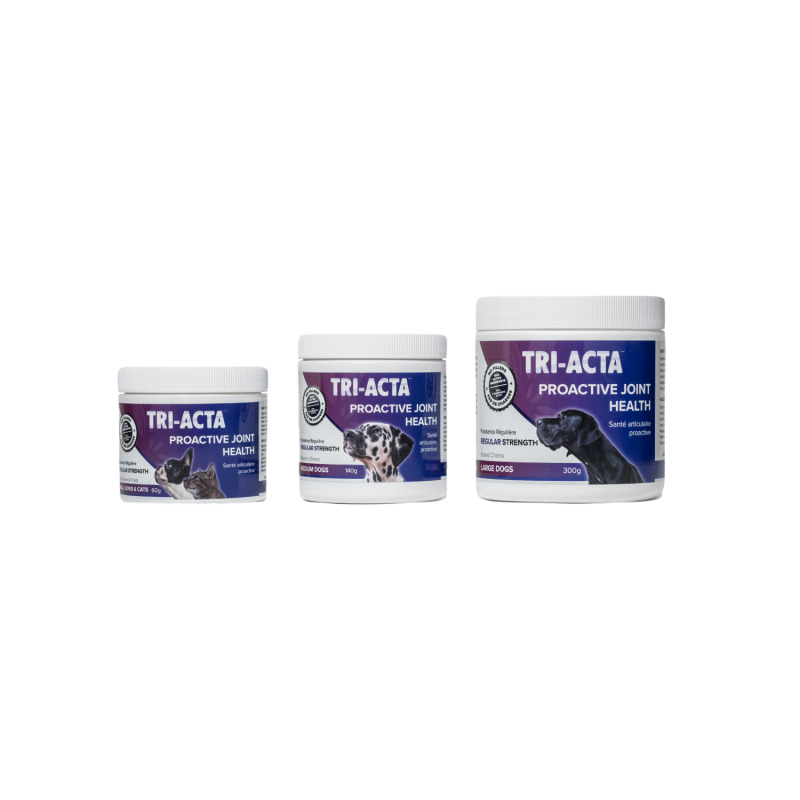
Medication
If your kitty has suffered a laceration or internal injury, your vet may prescribe medication to solve the problem.
There are plenty of medications you could be prescribed, but when it comes to cat leg injuries, two kinds are most commonly prescribed — pain medications and antibiotics.
Pain medications, specifically NSAIDs, to treat cat leg injuries are limited, and cats should never be given any human NSAIDs, like ibuprofen, as their bodies can’t break it down.
The only NSAIDs acceptable for cats are:
- Robenacoxib
- Meloxicam
Another common medication prescribed to kitties with an injured leg injury is antibiotics. If your cat has an injury that resulted in infection or is an open wound, your cat may be given antibiotics like Amoxicillin. It can be highly effective, and the course of medications will likely be short-lived.
Joint Supplements
Humans turn to supplements to heal faster and to support their recovery from a cat injured leg, and we can do the same for our pets.
And feeding a daily cat supplement can help your cat start feline better soon, too.
Supplements focusing on their joint health can help bring down inflammation inside their leg, and help improve mobility.
The thing is, not all supplements are created equal. You need to find a cat joint supplement that offers you therapeutic value in a format that makes sense for your cat and your wallet.
The best joint supplements for cats include the ingredients listed in the table below, but you should learn how to read a supplement label before you buy so you know exactly what would work best for your cat.
| Active Ingredient |
Benefit for Cat Leg Injuries |
| Glucosamine |
Assists in cartilage repair |
| Chondroitin |
Prevents cartilage from breaking down further |
| MSM |
Reduces pain and inflammation |
Integricare’s pet supplements include all of the joint health superstars listed above. If you’re looking for extra support, particularly for senior kitties or those recovering from surgery, TRI-ACTA H.A. offers the bonus of containing hyaluronic acid, which lubricates joints and improves synovial fluid viscosity.
TRI-ACTA H.A. for Pets
Our maximum strength formula is optimally designed to accelerate the formation of cartilage, minimize inflammation, expedite the healing process, and improve joint conditions.

Physical Therapy
Feline physical therapy may sound strange, but it’s purr-fectly normal treatment for a cat leg injury.
Offering your kitty everything from exercises to hydrotherapy for cats is something that is often helpful to those kitties recovering from injury and even surgery.
Cat injuries treatable with physical therapy include:
- Traumatic stifle luxation
- Fracture surgery recovery
- Femoral fractures
- Cat spinal cord injury
- Articular fractures
- Cruciate ligament injury
Your vet can help you to work out a plan that best fits your kitty’s needs, and even recommend you to the right practitioners that can help provide services such as massage and therapeutic ultrasound. A cat leg injury healing time can be greatly reduced with the help of the right physical therapy tools.
Frequently Asked Questions (FAQ)
Dealing with cat leg injuries can be confusing. That’s why it pays to know the answers to a few commonly asked questions. Here are a couple of Q&As to help clear up any other doubts you might have about a cat leg injury and how to handle it.
Cat leg injury healing time
Your standard cat leg injury will take about two weeks to heal. During this time you’ll want to encourage your cat to rest and try to limit his physical activity. Remember to also follow any additional instructions given to you by your vet.
How to clean a cat leg injury
If your cat leg injury is due to a wound, abrasion, or lesion, you’ll want to use warm water to clean the wound. Then, use soft paper towels to dry the cat injury. If the injury is particularly deep, hot compresses or salt water can help. Just note to avoid disinfectants as these can actually be toxic to cats and do more harm than good.
Will my cat's leg injury heal on its own?
Some kinds of cat leg injuries, such as soft tissue injuries, may be able to heal on their own. However, others will only get worse if left untreated. As a result, it’s always best to consult your vet if your cat is struggling from a cat leg injury.
Conclusion 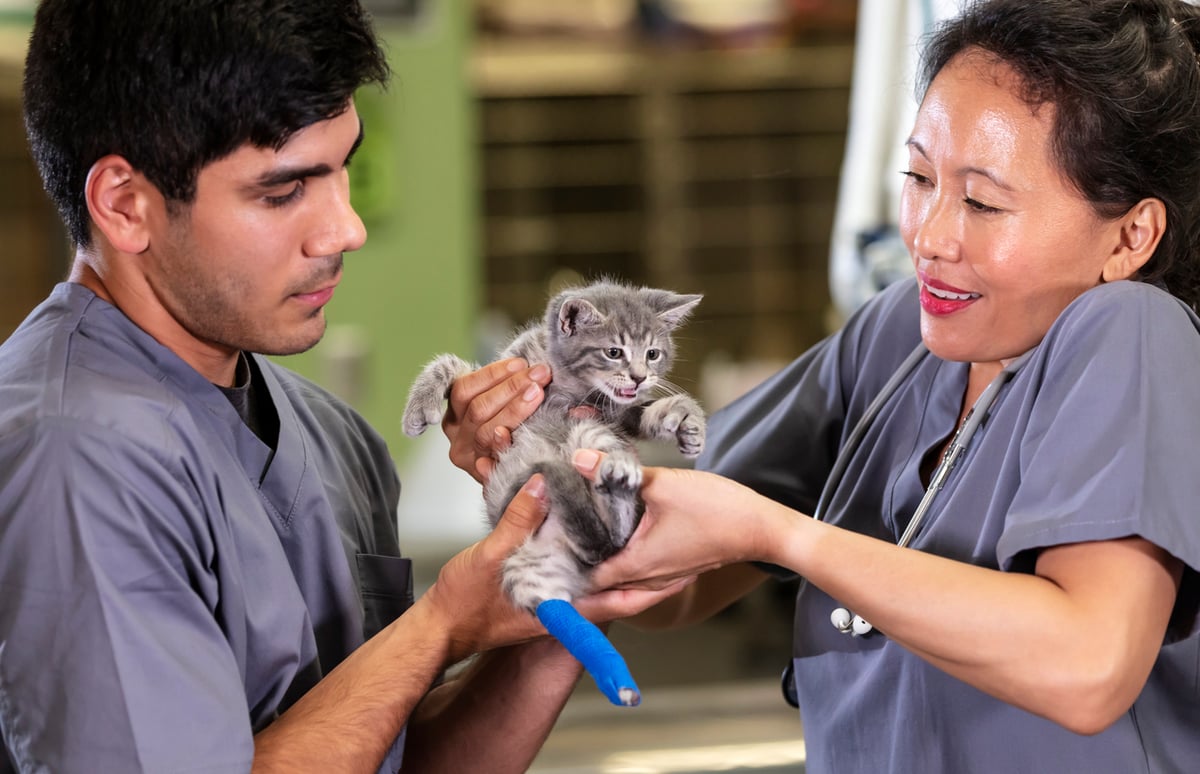
Our kitties love to be active and adventurous. They love to make daring leaps and show us their wild side every now and then.
But when your feline pal’s adventures lead to a cat leg injury, it is no fun for anyone.
You need to get them back to their playful selves. And one thing that will help do that is feeding your cat a supplement.
Supplements like Integricare’s TRI-ACTA for pets offer key benefits, including cartilage repair and inflammation reduction, both helpful in the prevention and treatment of cat leg injuries. Plus, TRI-ACTA offers you a therapeutic dose of high-quality ingredients in a small, easy-to-serve dose. That’s good for your wallet and for your kitty.
TRI-ACTA for Pets
A proactive approach for developing and younger adult pets to maintain optimal joint health mobility, minimize inflammation and fend off age-related ailments.

Find out where to buy TRI-ACTA or learn more about animal health on our blog.
Newsletter Signup
Subscribe to our newsletter to receive the latest news and exclusive offers.
.jpg?height=2000&name=Cliick_Integricare-DISPLAY-REVISEDV2%20(1).jpg)
Proactive & Therapeutic Joint Supplements
When given daily, Integricare joint supplements recover bone and joint injuries faster and help prevent mobility injuries from happening in the first place.

